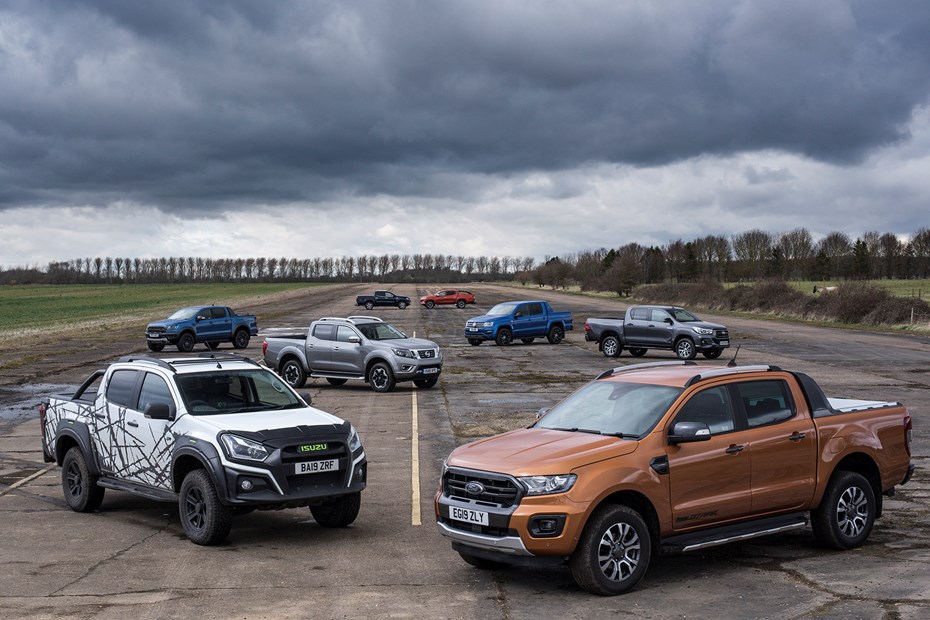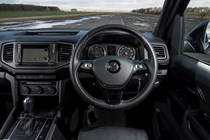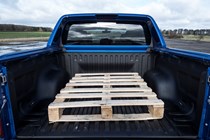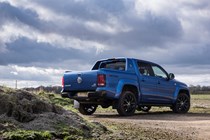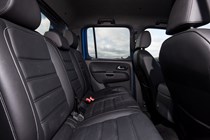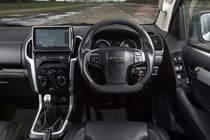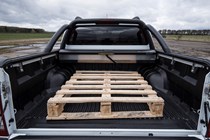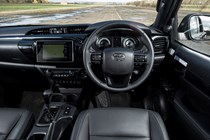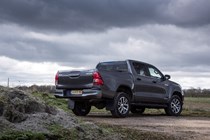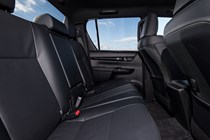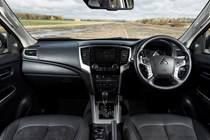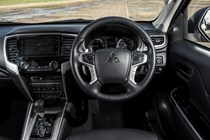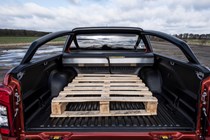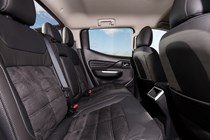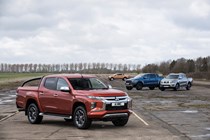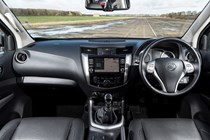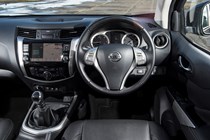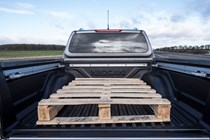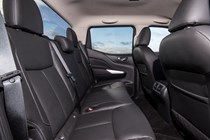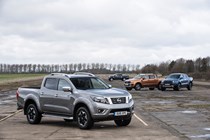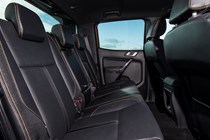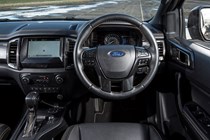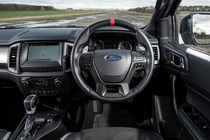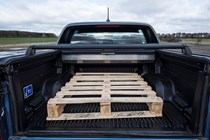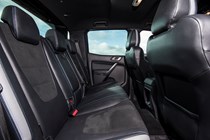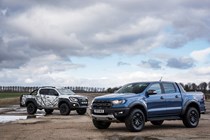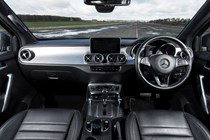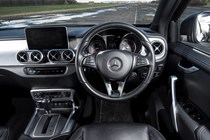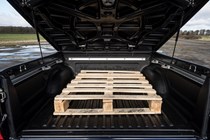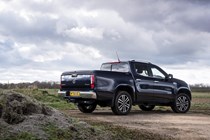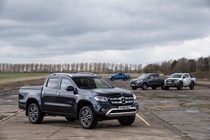If you’re considering a pickup truck as a working vehicle or an alternative to a passenger car, the double-cab 4x4 is the most versatile you can get. Most of them are highly competitive on price, too – higher-specification models often undercut SUVs with similar off-road ability, even before the tax advantages have been considered.
The selection on offer in Britain is shrinking, though, with just six core models to choose from. Still, to make it easier to narrow down your selection – for work, or play – Parkers Vans and Pickups has gathered them all together to help you decide in this mega group test.
We’ve rounded up high specification double-cab versions of (almost) every pickup currently on sale, plus a couple that will soon no longer be available new, to see which is best for you, and which is the UK’s best overall pickup.
Although many pickups are offered in utilitarian specifications, we’ve selected double-cab models for their popularity not just as working vehicles but also as family and lifestyle machines, plus their tax advantages for company car drivers and sole traders.
This also allows a fair comparison of convenience and technology features that are rarely offered on commercial vehicles, but taken for granted on passenger cars.
Which pickups are sold in the UK?
At the time of writing in 2020, these are the pickups currently available to buy brand new in the UK – clicking on the name will take you straight to more info about each one further down this page:
- Ford Ranger
- Ford Ranger Raptor
- Isuzu D-Max
- Mitsubishi L200
- Nissan Navara
- SsangYong Musso
- Toyota Hilux
In addition to these, you will also find examples of the following still available in the dealer networks:
To explain, the Amarok and the X-Class are being discontinued this year, while the Fullback and Challenger are both based on the previous-generation L200. All of these can still currently be found new or very nearly new, so we’ve included info on them for your guidance.
For the 2020 group test, SsangYong was unable to provide a Musso, but since we’ve covered over 14,000 miles in a 2019 Saracen in a long-term test we have plenty of experience with this model to draw on. Even so, it’s tricky to make a nuanced back-to-back comparison without a vehicle present, so it doesn’t feature heavily in the various test categories below.
What we’ve tested
Every pickup tested is equipped with four-wheel drive, five seats and four doors, and is available with either automatic or manual transmission; where possible, comparisons of both are included. Heated leather seats are common standard equipment at this level, and most have climate control and decent infotainment.
For a purely working environment, there are more basic specifications available; in some cases these have rear-wheel drive or less powerful engines.
To make it easy for you to choose the right pickup for your needs, we’ve judged them on on-road ability, off-road capability, towing capacity, comfort and costs, then ranked them according the best overall experience. 2020’s pickups show marked improvements in safety and refinement, though the oldest, most basic models still feel very agricultural compared with a car.
Ultimately, they’re all good working vehicles, and they’ve got lots of character, too – it’s hard to get a pickup you won’t like, but the difference in comfort between the best and worst is dramatic.
Want some pure data without opinions? Check out key technical specifications, dimensions and equipment for 2020’s lifestyle pickups.
What’s each pickup like?
Ford Ranger Wildtrak
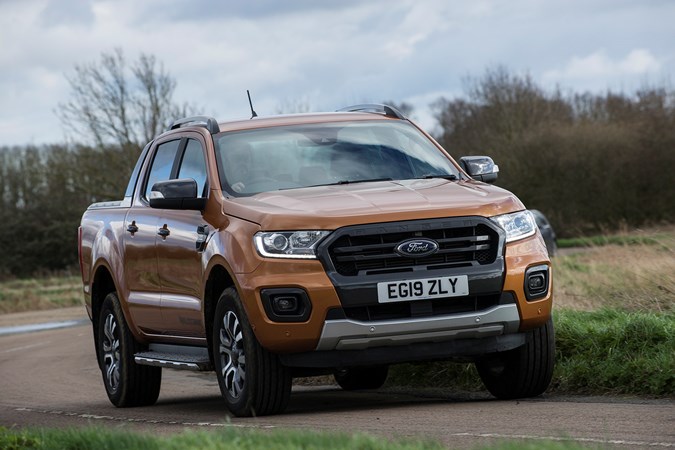
The Ford Ranger is the UK’s bestselling pickup, and if there were an award for ‘most improved pickup’, it would be a clear winner. The revisions made in 2019 were enough that it leapt ahead of the competition to take Parkers Pickup of the Year 2020, despite rivals’ efforts to refine their offerings as well.
The Ranger has a bold, distinctive identity with fit and finish the equal of Ford’s passenger cars, and an interior that feels more like a ruggedised premium car than a softened commercial vehicle. Ford’s Sync 3 infotainment system is impressive and easy to use, with a full suite of connectivity features.
Go for the top of the range, and the Wildtrak’s leather-trimmed interior, high-tech dashboard and comfortable, broad seats set a benchmark that is some way ahead of other pickup interiors. Drivers may find some of the controls fiddly though, particularly the hard-to-see temperature adjustment. Similarly the rev counter isn’t always displayed, buried away on a small display screen.
Refinement is further improved through technology – active noise-cancelling makes the Ranger one of the best pickups for long-distance cruising, and it’s got a comprehensive suite of safety tech too, from lane-keeping assist, to optional adaptive cruise control.
On the road there’s no disguising the Ranger’s size and weight, though the latest revisions include bespoke damping so more car-like specifications are firmer, more controlled, when utility models have a softer, but more jiggly ride. Steering and front suspension are much improved – though still a little slow and heavy compared to some Japanese rivals; it’s weighty rather than unresponsive.
Ride comfort is boosted by intelligently designed seats, so adapting to the feel behind the wheel is not a big deal. It’s a small complaint, really, given how well the Ranger translates American-truck attitude to European roads, and it’s an excellent long-distance hauler. Once sales of the 3.2-litre five-cylinder diesel end in May 2020, there’ll only one engine available – the 2.0-litre EcoBlue, with a range of outputs from 130hp to 213hp. This is one case where bigger isn’t better. so make sure you’re getting a good deal if you want the older model.
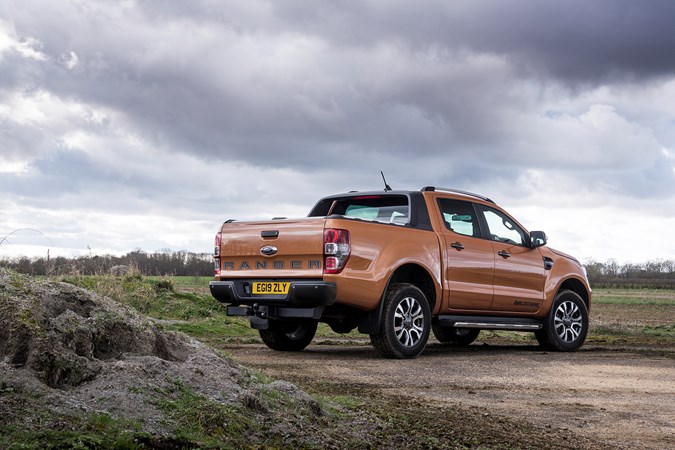
Standing apart from the Ranger’s commercial line up, the Ranger Raptor is a high performance off-road variant. Significantly re-engineered to maintain a high speed over challenging terrain, it’s also incredibly good on-road with the best handling and ride of any pickup officially offered in the UK – and potentially, of any pickup of this size outright. The modifications increase weight and reduce payload sufficiently that it’s no longer considered a commercial vehicle by HMRC. We’re considering it distinct from the rest of the range for this reason.
| Ford Ranger range | Single cab | Super cab | Double cab |
| Cost from | £20,845 | £24,609 | £25,409 |
Value for money: 4 / 5
Towing ability: 4 / 5
Comfort and luxury: 4.5 / 5
Running costs: 3.5 / 5
Warranty: Three years / 60,000 miles
>> Read the full Ford Ranger review on Parkers
>> Find a Ford Ranger for sale via Parkers
Ford Ranger Raptor
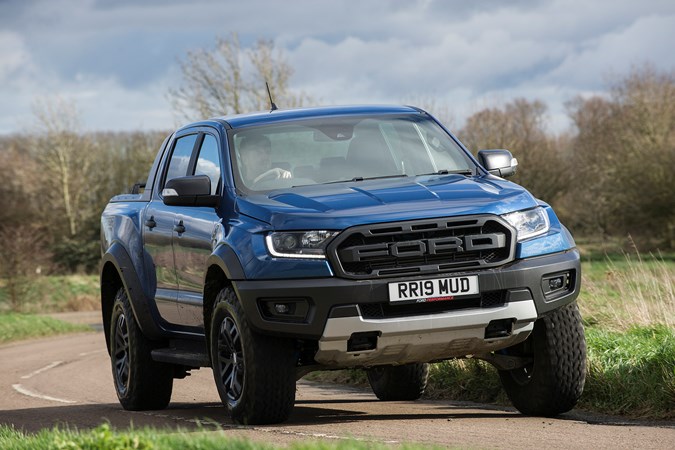
Still unsure if pickups are really taking over from SUVs as a lifestyle vehicle? The Ranger Raptor suggests that the makers of the UK’s best-selling pickup are taking that market very seriously – as it’s a £50,000 sports-truck that basically resembles a Ranger in shape, but not hauling ability.
The Raptor’s payload is just 620kg and it can only tow 2,500kg, limiting its usability as a workhorse compared with many SUVs, let alone pickups, and disqualifying it from reclaimable VAT as a commercial vehicle.
As a company car, not only is your firm unable to reclaim all the VAT, you’ll be paying more too – opting for a Ranger Raptor over a Wildtrak you’re be liable for £299.45 per month BIK instead of £57.17, and fuel benefit costs to match. That’s assuming you’re a 20% taxpayer, too.
Therefore the Raptor’s best considered as a rival to recreational 4x4s like the Jeep Wrangler. You’ll still save some money, as it is a commercial vehicle – which means it has fixed-rate VED. It’s much cheaper to tax than a £50,000 SUV with high CO2.
Downside? That N1 classification almost certainly means it’s legally limited to 60mph on dual-carriageways and 50mph on single-carriageways.
What’s so special about the Ford Ranger Raptor?
We’ve considered the Raptor as a distinct pickup because it’s a lot more than some flared arches and graphics – the rear chassis is completely altered, with coil springs and substantial trailing arms for flexibility, control and comfort, and the front suspension is similarly all-new and purposeful.
Reinforcement allows the Raptor to perform ‘kinetic recovery’ without damage to the structure – in other words, you can use it to pull other vehicles out of trouble with the factory-fitted attachment points, even if that involves need a bit of a jolt (it’ll take 4.5 tonnes of jolt).
The suspension is beefed up to the point that it can leap over off-road bumps, land and remain intact, and the brakes are up to the task of stopping a almost two-and-a-half-tonnes of pickup being driven like that.
In essence, the Ford Raptor is a fully capable rally-raid type truck you can buy from a Ford showroom for not much more than some mid-range SUVs.
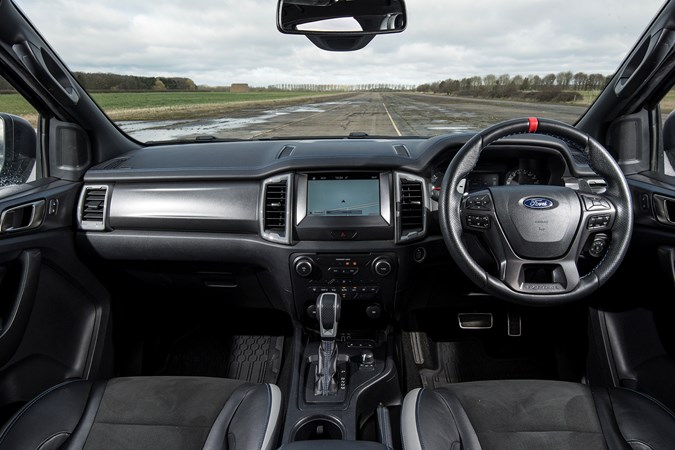
Much of the interior comfort and convenience is inherited from conventional Rangers – for practicality, infotainment and fit and finish, see the Wildtrak, as the Raptor’s sports interior is just as nice with some detail differences – notably, a great set of front seats, a permanent analogue rev counter and ‘sportier’ fonts on the controls.
However, the on-road manners are utterly sublime for a pickup. It rides better than many cars, corners well despite the off-road tyres, and is remarkably quiet aside from the tyre noise and gruff growl from the 2.0-litre diesel. Objectively, there are no downsides to the Raptor at all outside of payload, though the looks and attitude imply far more dramatic performance than 213hp can deliver – it needs a V6, badly, to cash the cheques the bodywork writes. But for any sensible driver’s needs, it’s more than adequate. Plus, too much power and you’d be sure the police would soon learn the kerb weight, class and limits applicable…
The Raptor’s real party trick is the exceptional value it offers; not that you could modify a standard pickup to the depth, quality and polish Ford’s revisions achieve. The roughly £6,500 premium over a similar Wildtrak would not go far spent on aftermarket mods.
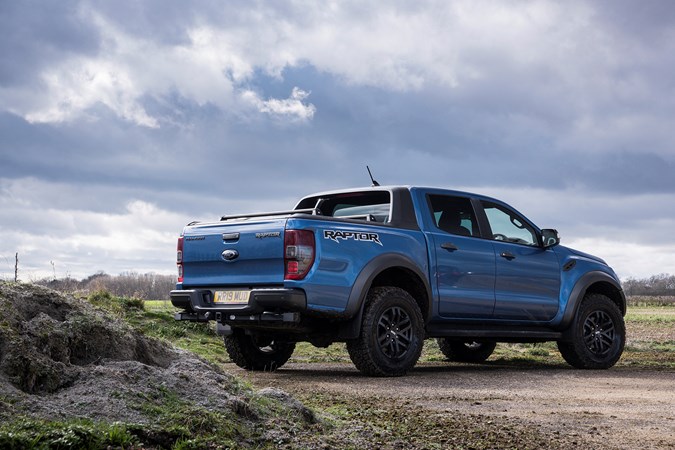
Business-based pickup buyers – a significant number in the UK – would probably love a Wildtrak-with-Raptor-looks, regular towing and payload capacity. If you’re spending your own, private money on a pickup though – VAT and all – this is probably the best money-no-object pickup ever officially offered in Britain.
| Ford Ranger Raptor | Double cab |
| Cost from | £41,256.37 (£49,305 on the road, including VAT) |
Value for money: 5 / 5
Towing ability: 2 / 5
Comfort and luxury: 5 / 5
Running costs: 3 / 5
Warranty: Three year / 60,000 miles
>> Read the full Ford Ranger Raptor review on Parkers
Isuzu D-Max XTR
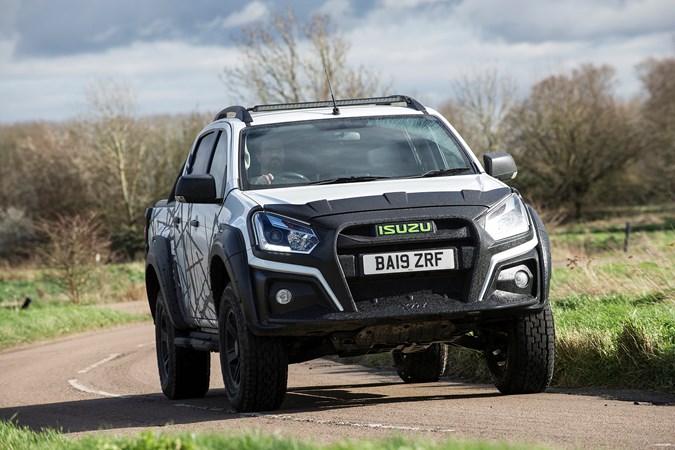
Of the pickups tested here, the Isuzu D-Max is usually the least pretentious, most utilitarian and the one least likely to be found parked outside Waitrose after the school run. The XTR, however, looks more likely to have emerged from a post-apocalyptic filmset, a dystopian prop that like it or loathe it, is impossible to ignore. Behind that intimidating bodykit is a very effective package of suspension upgrades, nearly all of which can be added to a less overt, better equipped, D-Max. The XTR is based on a Yukon, and though the modifications add some £9,990 to the price some core elements (such as the air conditioning) are as basic as they come.
Isuzu’s encroachment on the lifestyle market has been limited throughout the D-Max’s lifespan; that’s as much down to the dealer presence and brand identity as the pickup itself, however. Since 2017 the approach has been to go wild – with the purposeful AT35 and now the slightly wacky XTR to add showroom and kerb appeal without sacrificing that core off-road purpose. Even if you’re more lilely to drive away in a relatively tame Blade…
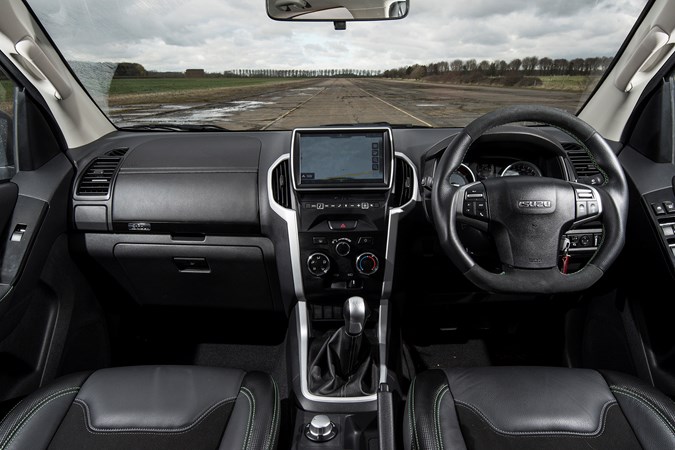
Knowing that its market is made up of people with a job to do, the D-Max means business inside. Big, robust controls that can be operated with gloves on, footwells and pedals large enough for work boots, and hardwearing materials are lifted by touches like roof-mounted surround-sound speakers on higher specification models, and some softer-touch areas on the dashboard.
For all the ‘dated’ elements of the D-Max – due to be replaced later in 2020 with an all-new model – Isuzu has been ahead of the curve under the bonnet. Even as rivals drop displacement, the D-Max has the smallest engine here. Its 1.9-litre engine produces 164hp, but has to work hard to do it. Given that it’s rated to tow 3,500kg, you’d be forgiven for thinking it’s barely adequate; you’d also be right. A fussy six-speed automatic gearbox doesn’t help matters; the six-speed manual is quite satisfying, but baulks on fast changes.
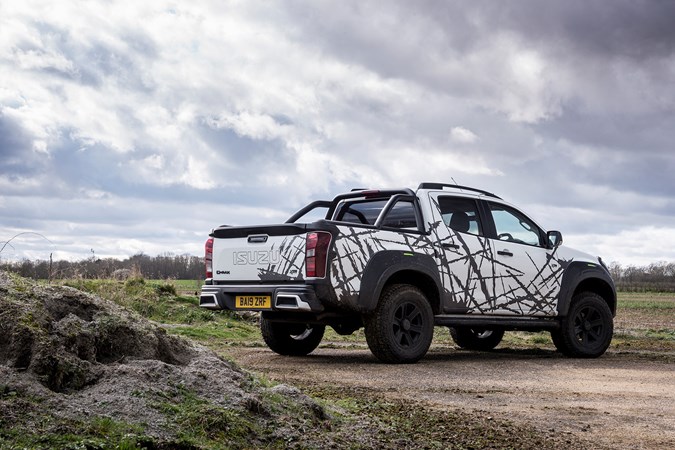
Lifestyle buyers won’t need to deliberate long over the D-Max; good as the XTR’s upgrades are, it’s still a long way behind rivals other than the Toyota Hilux – but serious off-roaders, grown-up kids and sensible landowners should consider the D-Max range for the customisation, value and solidity it offers for specific tasks.
| Isuzu D-Max range | Single cab 2WD | Single cab 4x4 | Extended cab | Double cab |
| Cost from | £16,909 | £19,209 | £20,009 | £20,809 |
Value for money: 3 / 5
Towing ability: 3 / 5
Comfort and luxury: 2 / 5
Running costs: 3.5 / 5
Warranty: Five years / 125,000 miles
>> Read the full Isuzu D-Max review on Parkers
>> Find an Isuzu D-Max for sale via Parkers
Mitsubishi L200 (Series 6)
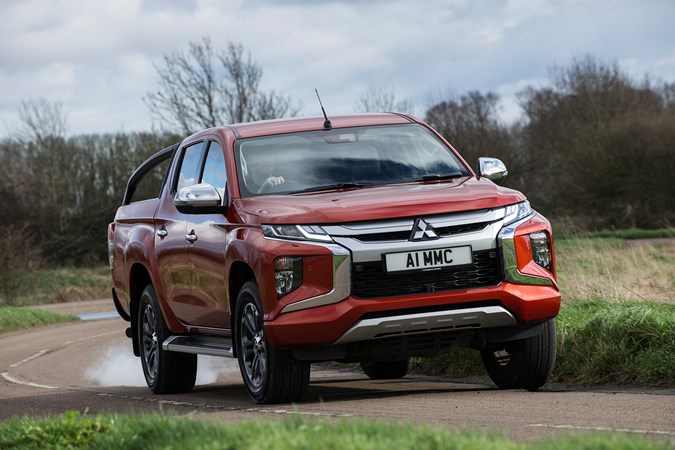
Once the UK’s favourite lifestyle pickup, the L200 has been thoroughly restyled for 2020 – at least outside. A new engine, and additional safety equipment, round-out the Series 6 which moves to a very SUV-like appearance, adopting the ‘dynamic shield’ look of the rest of Mitsubishi’s range.
Not everything is progress – in fact, there’s rather less progress on offer, as the environmentally-kinder 150hp 2.3-litre diesel is tasked with moving a heavier truck overall. Power-to-weight on the most lavishly eqipped models is down 25%, and you can feel it; the torque the old 181hp produced at 1,400rpm doesn’t arrive until 2,000rpm in the newer engine. It feels slower and is audibly working harder when laden.
Not helping the L200’s case is the now obviously-dated interior, which carries over from the Series 5 essentially unchanged (it’s got rear grab handles now, at least) with curves that bear no relation to the chiselled exterior.
Thanks to the relatively narrow body and progressively evolved chassis, the L200’s handling is nimble and predictable on A-roads and in town. The presence of full-time four-wheel drive helps – it adds security in the wet or on mixed surfaces, as well as off-road or on snow/wet grass. This user-friendly traction contributes a lot to the L200’s appeal, though it’s worth noting the most basic models have the same part-time 4x4 setup as rivals. Another benefit of the L200’s lighter build is the precise steering – albeit with a lot of turns lock-to-lock. It’s great off-road and at speed, less pleasant in car parks when there’s a lot of twirling to get into tight spaces.
A new six-speed auto improves efficiency, complete with paddle shift overrides – though there’s less obvious engine braking than the old five-speed auto. The addition of Hill Descent Control proves more effective off-road anyway. The manual gearbox has a moderately long throw, but is precise and smooth in use. Infotainment, like Mitsubishi’s cars, relies on a smartphone for navigation and streaming and is easy to use; what you get depends very much on the trim level but no L200 goes beyond the usual six-speakers, moderately loud audio benchmark of acceptability.
Towing capacity is a full 3,500kg, plus an impressive 590kg spare in the pickup bed – the L200 is only beaten on carrying ability by the SsangYong Musso. Rear passengers will find the upright seats less comfortable than the bigger pickups, but up front the relatively simple looking seats are surprisingly pleasant. It’s particularly car-like to drive, and the turning circle is good, but hampered by the long rear overhang. Although there’s a decent raft of safety kit, it’s only standard on the most expensive models.
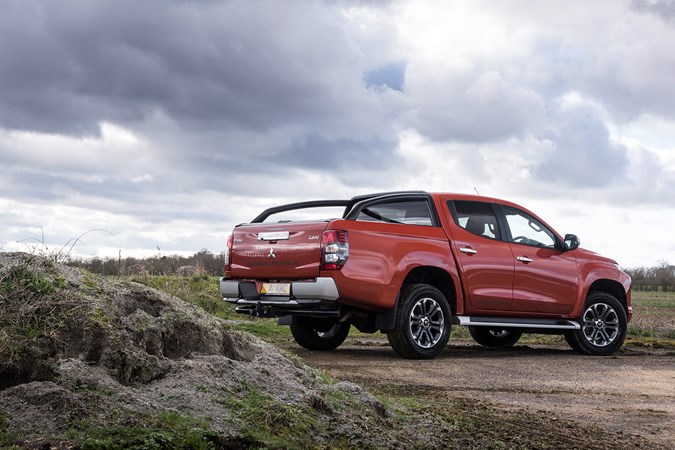
For the money the L200 remains a capable and convincing all-rounder, but the 150hp engine has taken the edge off – well, downright blunted – a once-engaging, charming lifestyle pickup.
| Mitsubishi L200 range | Club cab | Double cab |
| Cost from | £21,735 | £22,940 |
Value for money: 3.5 / 5
Towing ability: 3.5 / 5
Comfort and luxury: 3.5 / 5
Running costs: 3.5 / 5
Warranty: Five years / 62,500 miles
>> Read the full Mitsubishi L200 review on Parkers
>> Find a Mitsubishi L200 for sale via Parkers
Nissan Navara
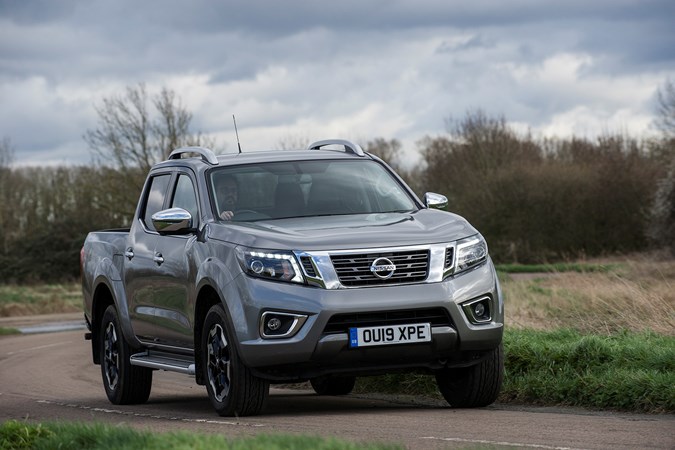
For 2020, the Nissan Navara stands alone – shared-platform rivals from Mercedes and Renault are absent (the latter never having appeared in the UK in the first place). It’s been refreshed, too – new infotainment with Apple CarPlay livens up the interior and a twin-turbo 163hp version with improved torque puts a bit more pace into the lower-spec models.
Coil springs are now fitted on all models, not just double-cabs, and the rear suspension has been jacked up to help with heavy loads – but the biggest improvement comes from substantially upgraded brakes with discs all-round. This is the biggest difference you’ll feel; they’re very effective, controllable and precise. Steering is also better, with less jitter and vagueness.
Nissan’s generous and advanced tech remains, such as a surround view camera and clever pickup bed attachment points. It’s consumer-friendly, be that for family life or work, but it’s a little cramped in the rear compared to rivals..
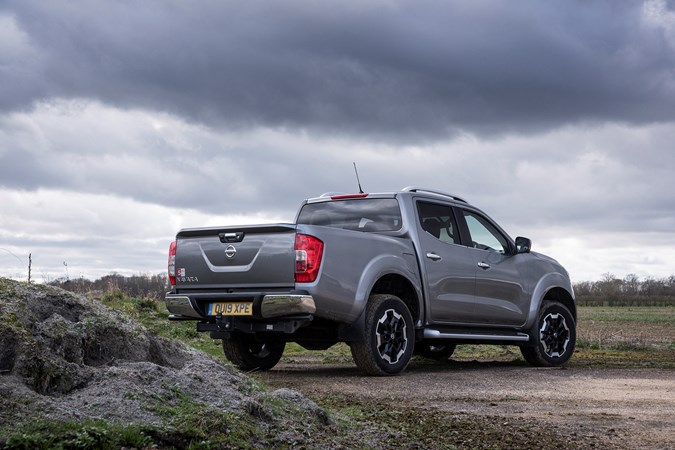
High speed stability is commendable thanks to the car-like coil-spring suspension, but this is rather firm and can be unsettled by bumps which results in a rather unwieldy feel away from the motorway. It’s still not the best when fully laden either. Off-road ability can be enhanced with an optional locking rear differential, and it’s also one of the few pickups offered in the UK with a sunroof, if you like a bit more light in the cabin.
| Nissan Navara range | King cab | Double cab |
| Cost from | £22,650 | £23,500 |
Value for money: 3 / 5
Towing ability: 3 / 5
Comfort and luxury: 3.5 / 5
Running costs: 3 / 5
Warranty: Five years / 100,000 miles
>> Read the full Nissan Navara review on Parkers
>> Find a Nissan Navara for sale via Parkers
SsangYong Musso
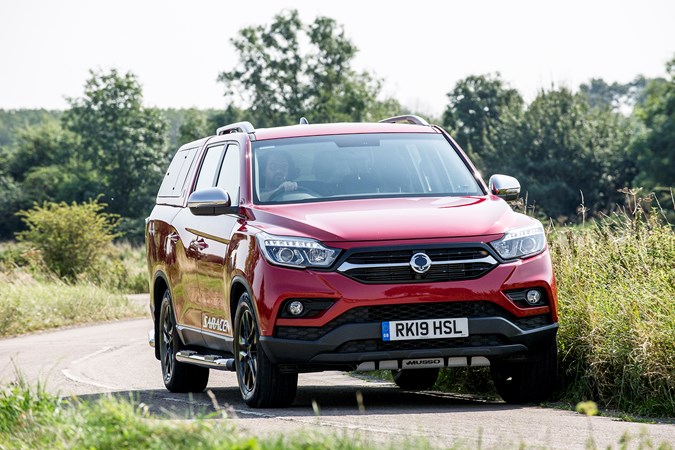
This year, SsangYong was unable to provide a Musso for our group test – but it’s fundamentally unchanged from the 2019 model. For 2020, the biggest change is the addition of AdBlue; with no change to the engine’s performance otherwise, it’s now the one of the most powerful pickups on sale in the UK.
At the time of writing the Musso comes in one bodystyle – with the shortest overall length and shortest load space of any UK pickup, despite the impressive weight it can carry – and with a refined, powerful 2.2-litre 181hp engine. It also includes the longest warranty of any pickup in the UK, at seven years or 150,000 miles.
Drivers moving over from an SUV will find the Musso the most car-like inside, thanks to the amount of body and trim shared with, the Rexton SUV and a thorough approach to refinement that sees more body sealing and insulation used, alongside coil springs all-round. The result is as you’d expect – a solid, generally attractive ‘budget luxury’ feel that falls short of European SUV standards, but is very good for a commercial vehicle at this price. We ran a Musso Saracen long-term test for over six months and 14,000 miles if you want a full in-depth review of how effective it is as a family car and lifestyle pickup.
Around £28K excluding VAT gets a Musso in top-spec Saracen trim. It’s got a 9.2-inch touchscreen infotainment system with Apple CarPlay, heated and cooled front seats trimmed in high-end Nappa leather (rear seats are also heated), and it was the first UK pickup with a heated steering wheel – yet more elements shared with the Rexton.
Interior space is a Musso strength, and on paper it’s a strong contender for most purposes, but it comes almost frustratingly close only for small flaws to highlight that this is a budget pickup. Its biggest weakness is brand identity; objectively that shouldn’t matter, but when your rivals include Ford and Mitsubishi, and names like Hilux or Ranger, the bar’s been set very high to impress loyal pickup buyers.
| SsangYong Musso range | Double cab | Musso Grand |
| Cost from | £21,995 | TBC |
Value for money: 3.5 / 5
Towing ability: 4 / 5
Comfort and luxury: 4 / 5
Running costs: 3.5 / 5
Warranty: Seven years / 150,000 miles
>> Read the full SsangYong Musso review on Parkers
>> Find a SsangYong Musso for sale via Parkers
Toyota Hilux Invincible X
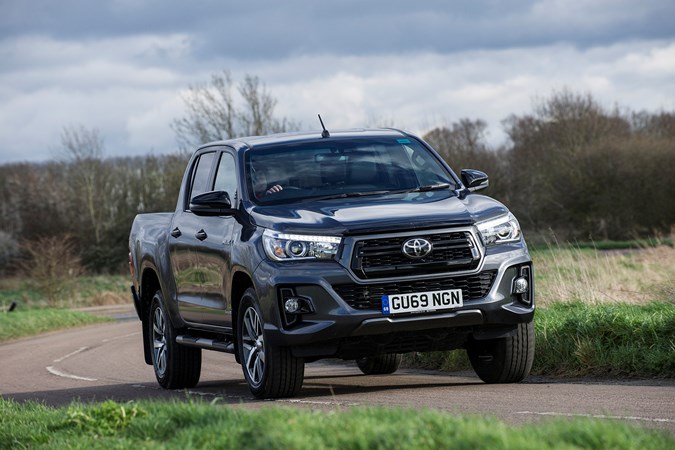
For many British drivers, the Toyota Hilux is the definitive working pickup; over several generations it’s proven reliable, capable and trustworthy for countless farmers and construction firms.
What the Hilux hasn’t grasped fully is the concept of a pickup as a want, rather than a need, so that reputation is built on functionality and strength. It’s justified, but makes considerably more sense as a single cab, low-spec model with rubber mats and a 2.3 metre-long load bed, than it does as a five-seater luxury SUV alternative. From the very start, the lack of adjustment for the passenger seat, the unyielding hard plastics of the door trims and dashboard, the strangely sharp-edged ‘leather’ steering wheel all indicate a vehicle that means business and is being asked to civilise itself, like an ex-Marine security officer tasked with babysitting the President’s grandkids.
The 150hp, 2.4-litre diesel can take the tough Toyota from a standstill to 62mph in 12.8 seconds – just about fast enough for typical British traffic, but it’s not very relaxed or refined about it. The switchable modes for eco and power have a marked effect when paired with the manual transmisson; the smooth automatic evens-out the feeling of torque-driven urgency.
Once up to speed you can enjoy the unusually effective adaptive cruise control (above 20mph) of the top-spec Hilux. There’s also a form of active lane-keeping, but it’s supposed to prevent accidents, not induce stress – and frankly, it’s terrifyingly sudden if you forget it’s on and approach a road with split markings. These concessions to luxury are soon eclipsed by the jiggly ride when unladen – old-school pickup behaviour at its finest. It’s safe and handles well, but it isn’t cosseting.
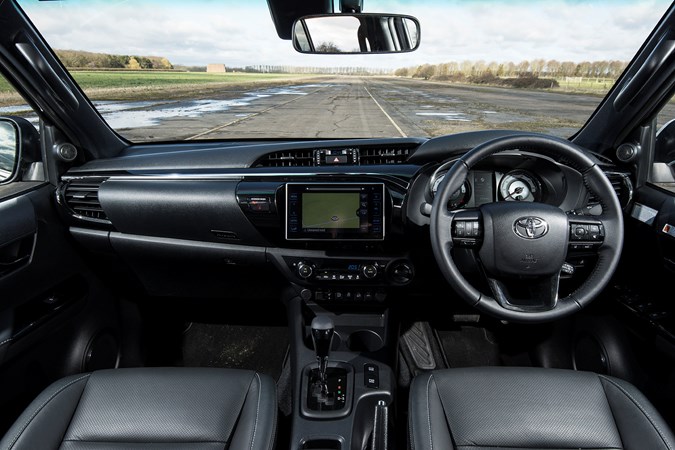
Toyota’s approach to interior design is somewhat confusing, as the Hilux’s very car-sized (it feels almost cramped next to rivals) interior is made of very tough, unforgiving hard-wearing materials, yet it’s boldly styled around a large central infotainment screen and visually interesting. On cheaper models, this position houses a very basic radio. The shapes would suit a luxury car, with some real elegance of line in there – but the plastics feel like something you’d bathe a sheep in and still be using 20 years later. Perfect for the realities of working pickup life, but it won’t win over anyone who expects Range Rover refinements or even £30,000 family SUV comforts.
If you like it, though, the Hilux has remained well-made and robust enough that you can be confident of a long working life, and Toyota dealers are some of the best around. Keep it until it cannot work anymore, and that value for money should be a solid 5 / 5.
| Toyota Hilux Range | Single cab narrow body | Extra cab | Double cab |
| Cost from | £20,423 (£20,725 wide) | £21,981 | £22,756 |
Value for money: 3.5 / 5
Towing ability: 3 / 5
Comfort and luxury: 3 / 5
Running costs: 3.5 / 5
Warranty: Five years / 100,000 miles
>> Read the full Toyota Hilux review on Parkers
>> Find a Toyota Hilux for sale via Parkers
Last orders, please
Volkswagen Amarok Aventura Black Edition
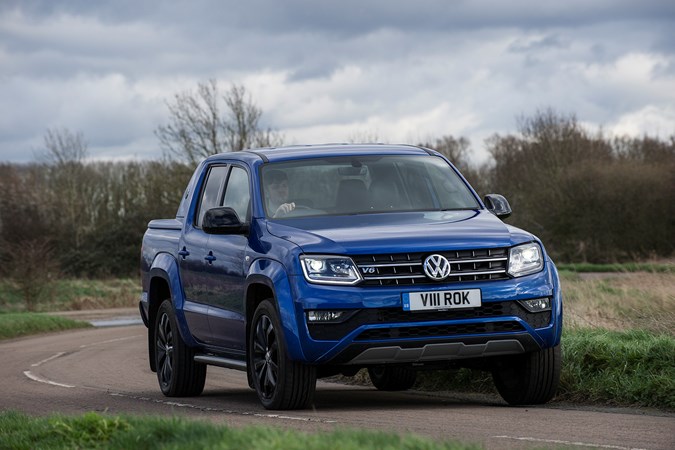
Spring of 2020 is the last opportunity you’ll have to order a new Volkswagen Amarok for a while; order books will close in May 2020 and a replacement, under development with Ford, is unlikely to show up until 2022. But despite having been launched in 2011, the current model still feels like it’s setting the pace rather than following. Its clean-sheet design owed nothing to prior pickups, and it’s been steadily improved every year – it will be interesting to see if the next Ford-VW joint pickup will owe more to the Amarok’s evoluion than the Ranger’s.
Volkswagen is a master at maintaining brand value through a strong identity, and if you want something that’s basically the pickup equivalent of a Golf, this is it.
Not only that, it’s the GTI – no stripped-back economy specials here, as much of the Amarok’s appeal comes from its impressive V6 engines. Without significantly compromising the pickup’s ability as a working vehicle (it’s actually one of the most practical, too) VW has fitted seats that would be the envy of most luxury cars, high-end tech and a layer of attractive, functional design that sets it above the rest of the market.
It’s a big beast, and not the most nimble, but at speed it’s truly refined and comfortable enough to rival most SUVs.
That competence and performance does come at a price; this is the most expensive pickup offered in the UK apart from the now-departed X-Class – though unlike the Ranger Raptor, it does qualify as a commercial vehicle for tax and BIK purposes.
| VW Amarok range | Double cab V6 |
| Cost from | £29,555 |
Value for money: 3 / 5
Towing ability: 3 / 5
Comfort and luxury: 4 / 5
Running costs: 2.5 / 5
Warranty: Three years / 100,000 miles
>> Read the full Volkswagen Amarok review on Parkers
Choosing a pickup
Pickup for fun
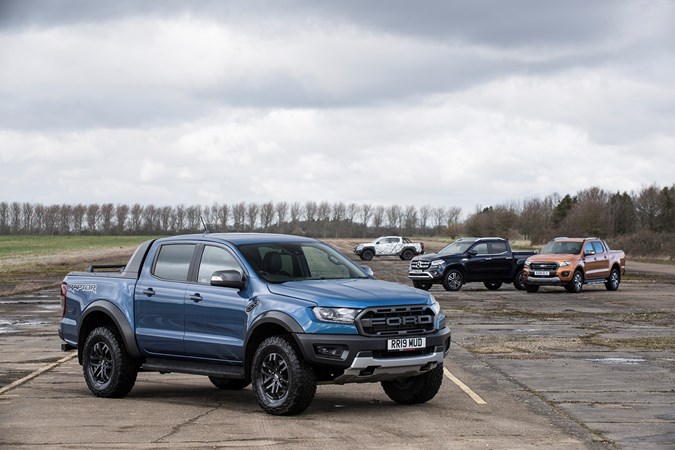
Be honest. If you wanted a pickup for work, you’d choose the single-cab utility models unless you really need space for crew; and even then, there are stripped out, rubber-trimmed models for that. These high-spec pickups are essentially chosen because they look cool, have a lot of bling and signal a life of adventure, excitement and really wild things – not carting minimixers to building sites. That’s why it’s important that your family and other passengers aren’t being subjected to anything too agricultural – you may want to feel like a big kid behind the wheel, but if no-one else is having fun it can get a bit boring!
This year’s reduction in power for the L200 means relegation to the ‘safe-but-comfortable’ side of the equation – and the fun now comes in two flavours. The Isuzu D-Max XTR and the Ford Ranger Raptor. Objectively, the Ranger Raptor is the answer to every single question you might have; it’s devastatingly capable off road and deeply impressive on-road too, given the immense weight and width. It’s got chiselled, brutish good looks, and it’s lavishly equipped and comfortable too. At £49,000 it’s also very expensive, but that’s actually £41,000 in commercial vehicle terms.
There’s the catch, though – the Ranger Raptor can’t carry the one-tonne payload that it needs to qualify as a ‘van’ in the eyes of HMRC, so it doesn’t get the tax advantages of rivals. It’s great value to buy in cash terms, but in terms of business expenses – the main reason you’d choose a pickup over an old-school 4x4 SUV in the first place we’ll wager – it’s five times the monthly cost.
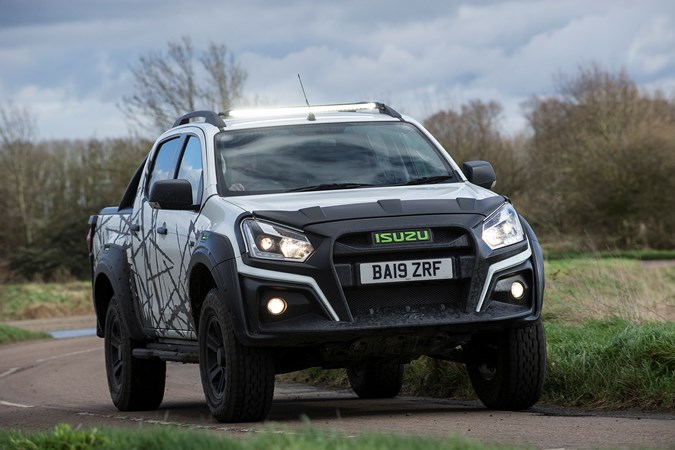
The Isuzu D-Max is almost a homebrew Raptor, as if the A-Team were locked in a shed to prep a basic D-Max to compete in an off-road race – but they had time for a trip to Halfords’ audio department on the way out. At £34,000 in most basic form, and yes, almost £40,000 by the time you’ve added some shiny stuff to approach the Raptor’s sophistication, it’s hard to believe they’re the same price when sat side-by-side. Not only does the XTR start life as a bare-bones Yukon, meaning no climate control or fancy gadgets; it’s got less power and less refinement.
Somehow, the Isuzu XTR delivers far more than the parts suggest. The sports seats are comfortable, the small steering wheel pleasing and remarkably precise, and it really does make the most of that 1.9-litre engine when paired with the six-speed manual. It’s extremely capable off-road, and wouldn’t be far behind a Raptor on a good A-road – but you’ll be working hard when the Raptor driver’s just chilling out; as good as the modifications are, it’s still unsettled and jittery against the Ford.
The XTR’s biggest rival is really ‘a secondhand D-Max and some Pedders upgrades’; the green-lane/pay-and-play enjoyment is heightened by not having a shiny, £40K toy to damage.
This is all very silly – can you get a sensible fast pickup?
Against this pair of unashamed ‘big boys’ toys’, grown-ups should move fast and get orders in for the VW Amarok. It offers badge prestige, solid road presence and genuine passenger comfort and refinement, backed up by a four-wheel drive system that’s seamless in operation. It’ll shame the occasional hot hatchback (let alone obliterating the Raptor and XTR) down a motorway sliproad just as easily as pulling a boat and trailer up a harbour slipway, but it’s not particularly nimble or fun to drive down congested urban streets.
For value, competence, versatility and kerb appeal the Raptor wins by a significant margin. In fact, if it weren’t for the irritating reality of ‘actually being useful for hauling things’, the Raptor would be the best pickup offered in the UK.
Winner: Ford Ranger Raptor
Alternatives: Volkswagen Amarok, Isuzu D-Max XTR (or a DIY equivalent)
Performance pickup
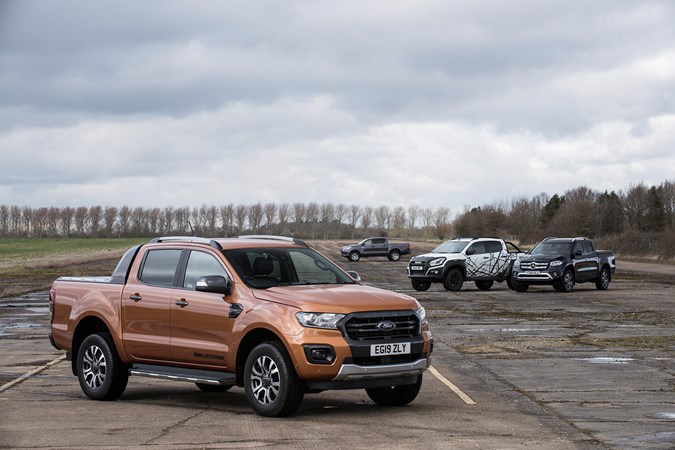
Fans of fast pickups, we’re sorry. 2020 marks the end of crazy 0-62mph dashes and ludicrous in-gear punch, and separating the trucks on offer on such a simple benchmark now becomes an exercise in splitting hairs. Until it goes off sale, the Volkswagen Amarok is the undisputed champion, hitting 62mph from a standing start in 7.4 seconds and reaching 129mph – but after May, new pickup buyers looking to make a quick getaway will want to look to Ford, Nissan and SsangYong.
Perhaps unsurprisingly, the Ford Ranger’s 213hp and 500Nm, plus 10-speed automatic, makes it the swiftest double-cab pickup of 2020. It can achieve 62mph in 9.0 seconds; the heavier, but differently-geared Raptor is just a second behind. Unless you’re on a strict budget, there’s no reason to deviate from the choice thousands of British pickup buyers make every year here.
If you do want something other than the Ford, the high-speed refinement of the SsangYong Musso comes in at a much more affordable price, and the Nissan Navara’s mid-range, twin-turbo urge is very useful on challenging roads.
If load and towing capacity aren’t part of the equation, tax breaks aside the Ford Ranger Raptor is an excellent all-rounder that deserves this title more than any rival.
Winner: Ford Ranger (and Raptor)
Alternatives: SsangYong Musso, Nissan Navara
Pickup for family life
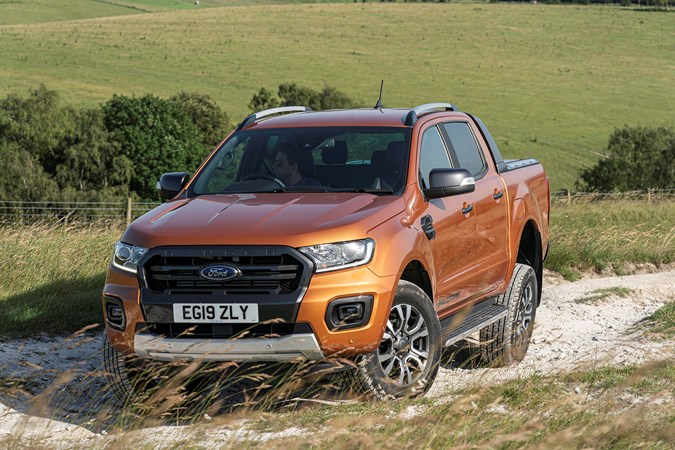
All of 2020’s pickups make a solid case for themselves as family transport – though parents with babies or toddlers and all their associated paraphenalia will need a cover for the load bed, as the cabins are invariably devoted to passengers only.
For drivers who expect car-like safety tech, this is a great year to buy a pickup. The Ford Ranger comes with autonomous emergency braking, cruise control, lane-keeping, pedestrian protection and pedestrian protection from the XL model upwards, with optional adaptive cruise control and parking assistance on Limited and Wildtrak.
Refinement still lags behind cars, with a couple of exceptions – the Ford Ranger Raptor rides and handles like a giant tall car; it’s smooth, responsive and benefits from most of the Wildtrak’s safety kit (not all of it); it has a load cover with rails as standard for secure storage plus accessories like bike carriers (it’s also equipped with a towbar as standard, ideal for caravans). It’s expensive, though, and if you’re looking at staying below the cost of a comparable SUV the SsangYong Musso is the best bet. It’s spacious and car-like inside, and very refined on the motorway thanks to class-leading body sealing and insulation – though the ride’s still a bit agricultural at times and it lacks the latest safety tech.
We can’t decide what’s most important to you, be it a car-like, comfortable environment with loads of space, or safety technology to match typical family SUVs. The Musso’s body and cabin is so different to rivals that it’s the only clear alternative in an otherwise very closely-matched pack, but the Ford Ranger offers the most complete package of pickup and car qualities combined. If SsangYong included all the technology it has available on Korean and Australian Mussos, it would lead this category
Winner: Ford Ranger
Alternatives: SsangYong Musso, Mitsubishi L200 Barbarian X
Luxury pickup
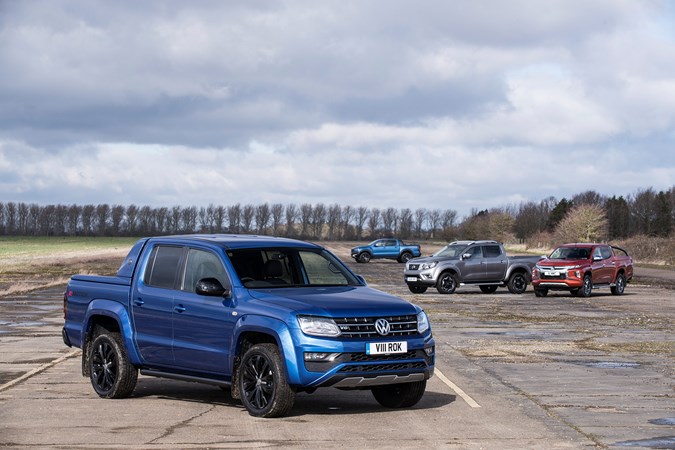
It is very easy to be distracted by low BiK and claimable expenses – but the truth is, these pickups cost as much as some very luxurious cars when you include the VAT you’ll be paying on top of the lease or cash prices. Consider them comparable to a £40,000 SUV – then look at the spec. Can they match it?
Some can get surprisingly close. The most luxurious of all is the Volkswagen Amarok Aventura Black Edition; it includes such luxuries as 14-way adjustable seats that provide unmatched comfort – in many cases you’re still perching on seats that don’t even tilt in its rivals. Yes, it should be comparable with a £40K SUV because it costs £40K before VAT, but it will save you a lot in tax compared to a Touareg, and may depreciate less too.
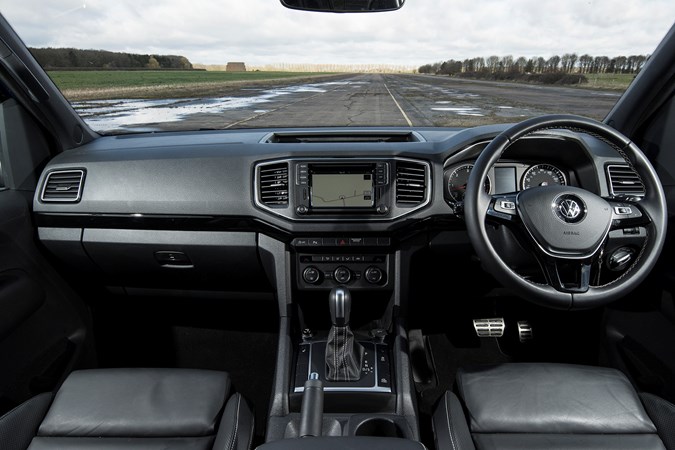
The Amarok’s days are numbered, so the crown falls to the next in line in May – and yes, you’ve guessed it, it’s the Ford Ranger. This isn’t just a case of well-padded, fancy-trimmed seats – the Ranger’s civilised specification includes lane-keeping, adaptive cruise control, heated windscreen and steering wheel – you will find it hard to identify a serious gap in the kit, or quality, of a Wildtrak.
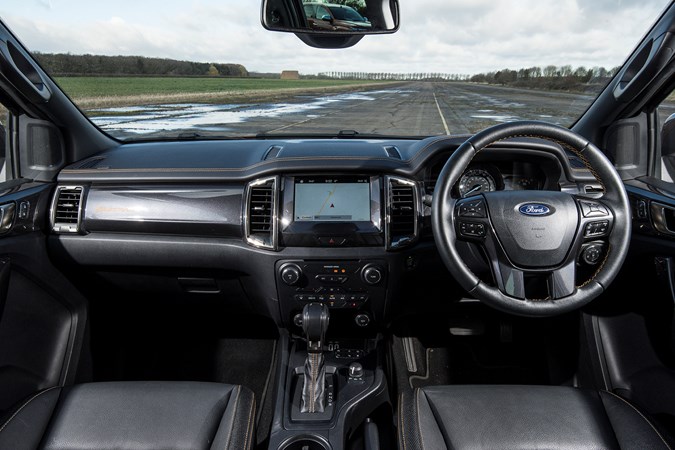
For the value-conscious, the highest-spec SsangYong Musso Saracen goes the extra mile for gadgets and refinement under £30,000. Excellent body insulation around the engine and doors, heated and cooled nappa leather seats and decent equipment levels are included without spending more than a top-spec family car; rather than being a crude agricultural vehicle wrapped in cotton-wool, the Musso’s foundations are ideal for making a civilised 4x4 – any shortcomings are down to a lack of high-end technology and keeping the luxury trim consistent throughout the cabin.
For many, the lack of badge prestige is also a factor, one we feel is worth overcoming if it means you’re going to sit on climate-controlled leather instead of unheated fabric for £28,000.
Winner: VW Amarok
Alternatives: Ford Ranger, SsangYong Musso (under £30,000)
Pickup for load carrying
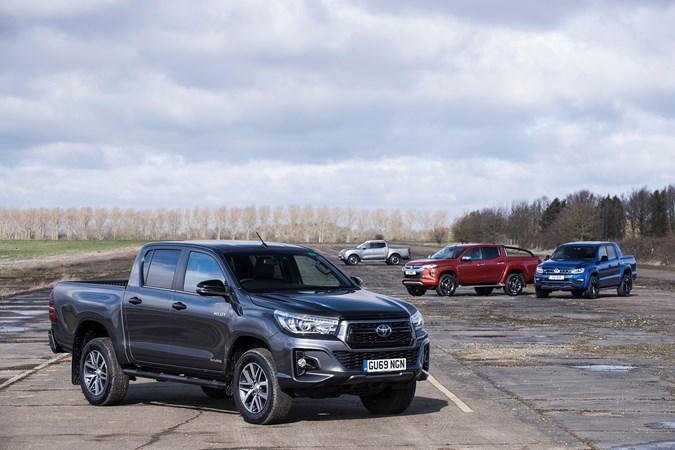
Space and capacity are everything here. You’ve guessed it already, the Volkswagen Amarok is a strong contender lugging loads, as the massive load bay not only measures 1,622mm wide by 1,555mm long, it can carry 1,114kg. It’s relatively low, too, meaning easier loading, and even the narrowest point between the arches is an impressive 1,222mm.
Toyota has squeezed an extra kilo of capacity out of the Hilux though, and it’s still got a decent size of load bed at 1,525 x 1,540mm. Given how much less you have to spend to get the Hilux – and the lower running costs – that’s the one we’d go for.
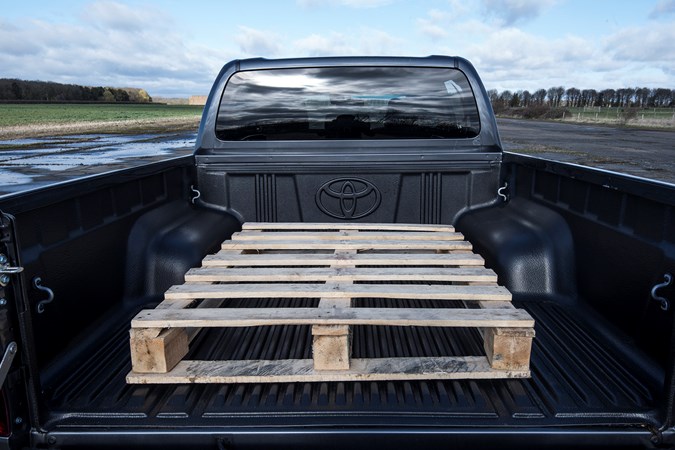
If the relatively spartan Toyota doesn’t appeal and you want more attitude from your truck, Ford has given the Ranger an ample 1,549mm x 1,560mm, with deep 511mm sides, and it costs considerably less than the VW too. Despite the flared arches and wider track, the Raptor’s cargo box is the same size internally.
You’ll want to avoid the Musso for big objects, despite the impressive payload capacity. It’s got the smallest load bed of any pickup here, at least until the larger Grand Musso is offered.
Winner: Toyota Hilux
Alternatives: Volkswagen Amarok, Ford Ranger
Off-road pickup

Every one of these pickups has a degree of off-road capability that puts most modern SUVs to shame, thanks to strong axles and a separate chassis (though sometimes limited ground clearance). For more regular off-road adventures, you’ve got three off-the-shelf options that give different advantages.
For fast, poorly surfaced roads, beaches or fields, the Ranger Raptor is engineered to travel as quickly off-road as most pickups will go on-road. It’s the ultimate plaything, but that means it’s really competent for work too – with the caveat that it carries and tows less than rivals. If you need to get to the top of the mountain, and back down, in comfort and confidence but without taking much gear – this is the one to have.
For crawling through forests, moors and post-apocalyptic wastelands full of cyberpunks, the D-Max XTR’s got the strength and slow-speed articulation to take anything on – and the looks to scare potential attackers and the occasional territorial badger into submission. Chances are, an experienced gamekeeper in a regular Yukon on decent tyres won’t be far behind you, but the XTR’s modifications mean that ridge, stump or rock that would stop most 4x4s can be scrambled over in confidence.
For slippery grass, mud and towing on loose surfaces, the full-time 4x4 of the Mitsubishi L200 is a technical advantage no other pickup offers in the UK (once the Amarok is no longer available). Combined with the right tyres for the job, it’s user-friendly and secure, it’s also useful on-road as well.
Those with really extreme off-road needs might also consider the Arctic Trucks conversions that are officially available in the UK for the Nissan Navara (AT32), Isuzu D-Max (AT35) and Toyota Hilux (AT35) – of those the Nissan has the most powerful engine but comes in a slightly lower specification than the other two.
Winner: Ford Ranger Raptor
Alternatives: Isuzu D-Max XTR, Mitsubishi L200
Pickup for builders
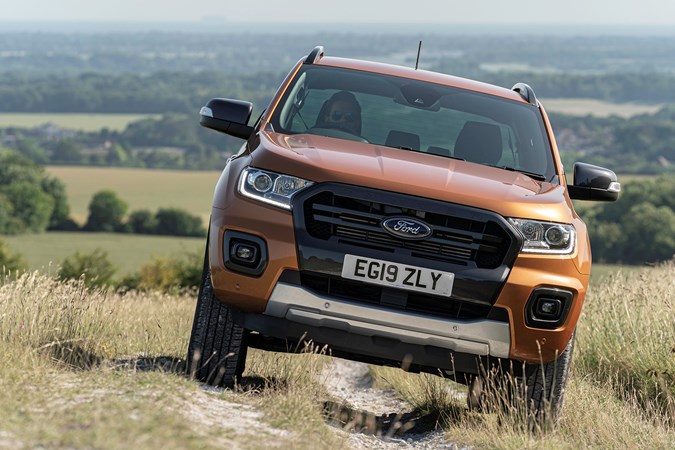
From building sites to showhomes, a quick extension to a multi-million pound contract, there’s one pickup that shines for looking good on the building site or financial institution alike – the Ford Ranger.
Not only does it have the option of adaptive cruise control, giving it a real advantage on long journeys, it’s got a tailgate that can support 220kg, too, making loading plant and materials easier despite the rear bumper, and 500Nm torque fed through a 10-speed gearbox makes towing heavy plant trailers less stressful.
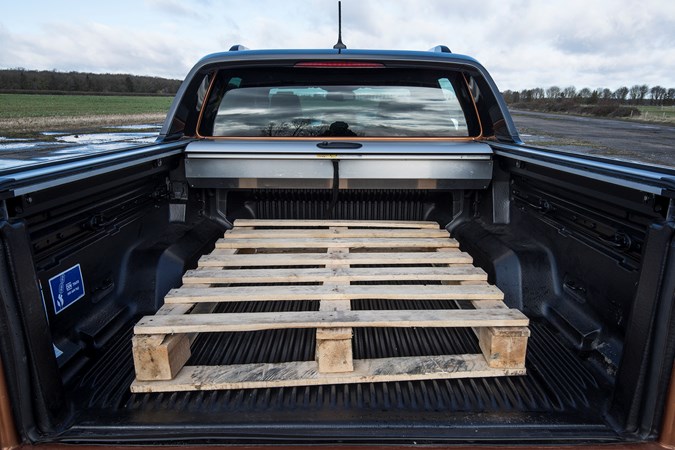
It’s also possible to optimise the transmission for towing or economy when ordering, an unusual degree of customisation that reflects Ford’s understanding of the commercial vehicle market.
Of course, the Volkswagen Amarok covers all the bases if you’re happy to spend the extra – but it has lower ground clearance.
Winner: Ford Ranger
Alternatives: Volkswagen Amarok, Nissan Navara
Pickup for farmers
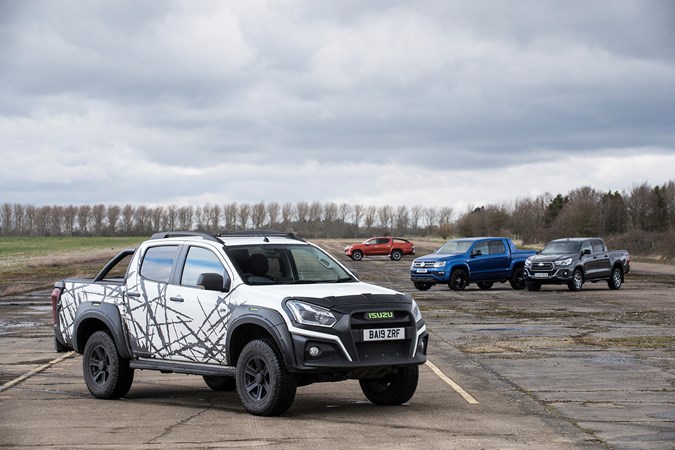
Land Rover’s Defender surrended its place as king of the particularly-slippery hill farm years ago – though the new Defender is poised to make a high-tech, high-capability comeback. In the meantime, the strength and versatility of pickups paired with low cost is a winning combination – and if you strip away the veneer of civility on the lifestyle models, two utility models stand above rivals for peace of mind, strength and even likability.
The Isuzu D-Max is a global success story, and unashamedly built for hard work. Its no-nonsense utility leaves you in no doubt as to where its strengths are.
A 245kg nose weight for the factory towing option is enough to handle most agricultural trailers, and it can pull 3,500kg – albeit slowly since it switched to the 1.9-litre engine in 2017. Anecdotally, we gather farmers were regularly towing 7.0-tonne loads with the old 2.5 twin-turbo. It’s also got a slightly roomier cabin, and feels less claustrophobic when wearing big boots and protective gear as a result.
Helping the farmer stay on – or off – the road without downtime, Isuzu’s dealer network tends to focus on remote rural locations and family-run garages that get to know you and your needs well. Isuzu also offers packages with aluminium hardtops and cages rather than aerodynamic fibreglass covers, so turnkey farming solutions are available without shopping around for bits. Isuzu are also very willing to discuss bespoke options – so if you do want a posh pickup, there’s a chance you can get everything from electrically deployed side-steps to family-crest embossed leather trim.
It’s hard to ignore the Hilux though – Toyota earned a reputation for unbreakable, faithful trucks the world over with this pickup. Rubber-matted and manual-gearboxed, the single-cab four-wheel drive wide body Hilux has a 2.3-metre long load bed and in Power mode, provides an impressive push through the rear wheels in all gears.
All the controls are weighted perfectly, with just the right amount of feedback from brakes and steering to feel confident off-road. Vocal when working hard, the 2.4-litre engine feels to have far more grunt than it does in the well-padded, luxurious Invicible X – without feeling like it’s been stripped back to the point of cheapness.
Overall, though, the D-Max is the better blend and impressive value.
Winner: Isuzu D-Max
Alternatives: Toyota Hilux, Mitsubishi L200
The Parkers Verdict
Perhaps the easiest decision we’ve ever made with a group test of this scale, the clear winner is the Ford Ranger. Massive improvements in refinement, some welcome technology and driver assistance that’s still relatively rare in this class of vehicle, and ultimately, the most powerful option available now the V6 pickups have gone, the Ford’s versatility and quality means it either wins, or puts up a tough fight, at every level of the market from single-cab workhorses to full-on luxury and performance models.
The changes were enough to ensure the Ford Ranger is Parkers’ Pickup of the Year 2020, and getting all of them together in one test has done nothing to sway that conclusion; if anything, it’s underlined just how thoroughly competent and polished the Ranger has become after eight years of sustained improvement and evolution.
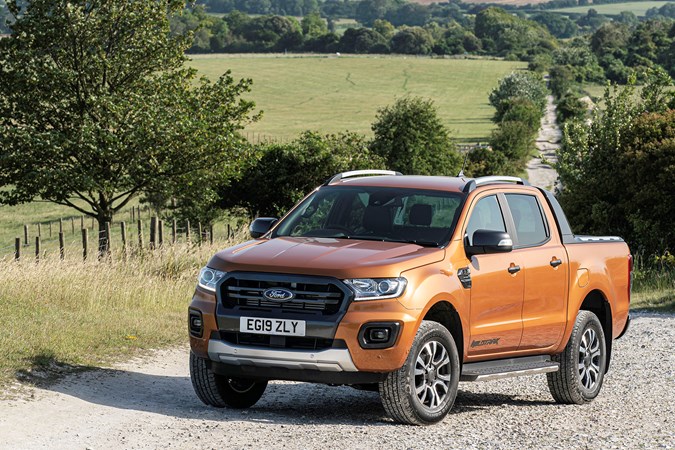
For family comfort and road refinement, the SsangYong Musso offers good value as a lifestyle pickup, but the lack of brand recognition and the rather bland identity holds it back; the L200 remains a very safe bet too – more so, now it has extra driver assistance and safety kit, but the drop in power has really hurt its appeal for long distances.
Did you really test all the pickups on sale in the UK right now?
Almost. We couldn’t get a SsangYong Musso this time, having just sent our long-term Musso Saracen back. Our conclusions are based on comparisons made during the year and it hasn’t been marked down for non-attendance in any way. It’s also worth noting that the D-Max XTR is very, very different to a conventional D-Max in ride and handling, so impressions of the D-Max are also based on Yukon, V-Cross and Utility models tested in 2019.
Gone – but not forgotten – some pickups worth buying while stocks last
This year has seen a significant reduction in the number of pickups offered in the UK – with three brands dropping out entirely (Fiat technically stopped offering the Fullback before the end of 2019) and Ford sticking to schedule for the end of five-cylinder Ranger production. The Series 5 L200 Challenger remains on sale at the time of writing, but probably only while stocks last.
Mercedes-Benz X-Class X 350 d
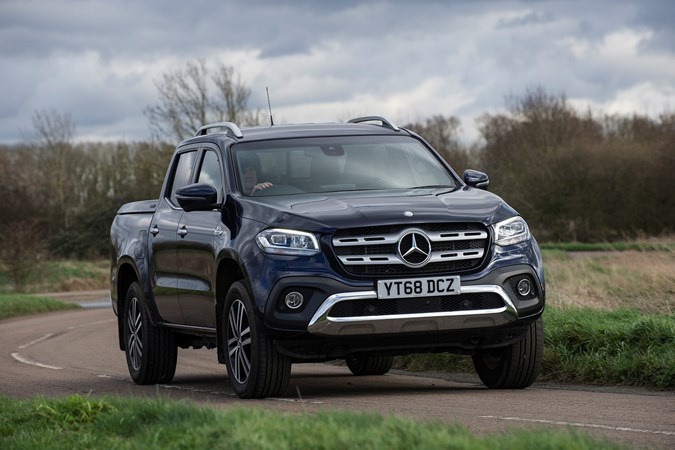
When the X-Class arrived, the excitement of a Mercedes-badged pickup was arguably tainted by the not-particularly-secret fact that it didn’t just share ‘some tech’ with the Nissan Navara, it was basically a Nissan with a fancy dashboard and pricetag. Nissan’s revised Navara may even have benefitted from some of Mercedes’ input – as the 2020 Navara has significantly improved ride, steering and braking.
Putting some distance between the Nissan and the three-pointed star, Mercedes-Benz’s unique V6 model diversified the range, but ultimately the Nissan origins may have been too much for buyers to overlook. The X-Class went off sale in the UK on 11 February 2020, though stock may remain available for a while – and there are some very good reasons to consider the X 350 d if you spend a lot of time in your pickup.
It’s got a deep reserve of torque and is refined, muted in how it goes about delivering it, effortlessly maintaining traction with permanent 4Matic four-wheel drive (the lesser X 220 d and X 250 d are identical to the Navara here, with part-time 4x4 setups). In isolation, it’s a fantastic pickup – if expensive – but if you’re used to Mercedes cars or the classic G-Wagen, it’s obvious the DNA originates elsewhere. The pointless bling to differentiate the V6 is a very un-Mercedes touch and the amount of Nissan plastic in the interior seems unjustified at the price (let alone the unchanged Navara key)…
As one of the most expensive pickups in the UK, the X-Class interior’s outclassed by the Ranger and Amarok, the performance is eclipsed by the VW in both numbers, and how it feels on the road, and ultimately it’s out of step with the rest of Mercedes’ style and tech for 2020. However – there’s a good chance that remaining unsold X-Classes will be offered at very appealing prices; if you can get a Mercedes pickup for Nissan or Mitsubishi money, you’d be crazy not to.
We’d much rather have seen the X-Class evolve than become extinct – the potential for the badge to justify a ludicruously-expensive Mercedes-AMG X 63 4Matic+ at near six-figure cost, or for Mercedes to bring a wealth of driver assistance, safety, comfort and style to the pickup market was exciting. If any unsold V6s remain at bargain prices, there’s still a lot to like in the X 350 d – but it’s worth noting that it was always outclassed in some regard by most of its rivals.
| Mercedes-Benz X-Class range | Double cab 2.3-litre | Double cab V6 |
| Price when new | £29.365 | £39,510 |
Value for money: 2 / 5
Towing ability: 3 / 5
Comfort and luxury: 4.5 / 5
Running costs: 2.5 / 5
Warranty: Three years / unlimited mileage plus 30-year Mobilo Van roadside assistance
>> Read the full Mercedes-Benz X-Class review on Parkers
>> Find a Mercedes-Benz X-Class for sale via Parkers
Fiat Fullback and Mitsubish L200 Series 5 (Challenger)
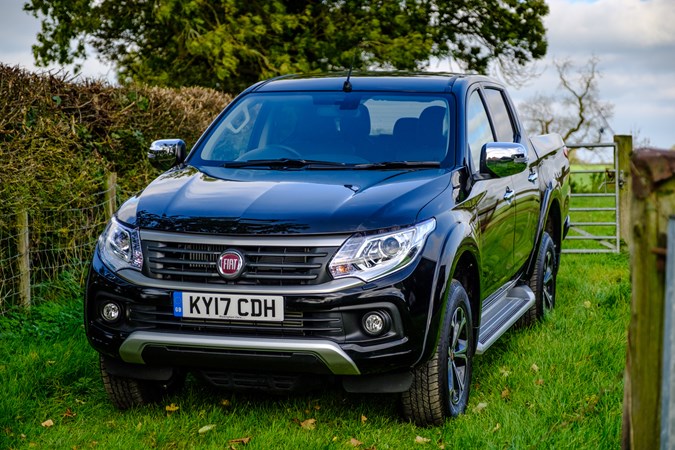
The Fiat Fullback 180 LX and Mitsubishi L200 Challenger (Series 5) are almost exactly the same pickup beneath branding. The 181hp, AdBlue-free 2.4-litre engine and five-speed automatic gearbox are the same, as is the body and chassis. A more distinctive variation is the Fullback Cross, which has better off-road ability thanks to a standard-fit locking rear differential and knobbly tyres in addition to the Super-Select II four-wheel drive system. It’s also got a cool sports bar as standard.
Tech lags behind the Series 6 L200 slightly, and the Fiat has a lower towing capacity than the L200 Challenger – it’s still at 3,100kg instead of 3,500kg.
Compared to 2020’s pantheon of pickups, the Series 5 L200 is relatively lightweight, and it’s got an impressive amount of power on tap too. It can put the power down effectively, which combined with a narrow body and decent handling makes it nimble to drive and relatively comfortable on long journeys. The ride can be a little unsettled when unladen on fast rough roads, but not worryingly so. You’ll also find full-time all-wheel drive, which helps with towing and feeling secure in poor weather.
Despite technology that’s a generation behind the current L200, the generous power and lively character of the Series 5 and Fullback is well worth seeking out if you’re not worried about extra safety kit or controlling urban emissions.
| Fiat Fullback range | Fiat Fullback Cross | L200 Series 5 Challenger |
| Price when new | £26,595 | £27,540 |
Value for money: 4 / 5
Towing ability: 3.5 / 5
Comfort and luxury: 2.5 / 5
Running costs: 2.5 / 5
Warranty: Three years / 120,000 miles (Fiat) – Five years / 62,500 miles (Mitsubishi)
>> Read the full Fiat Fullback review on Parkers
>> Read the full Mitsubishi L200 Series 5 review on Parkers
>> Find a Fiat Fullback for sale via Parkers
>> Find a Mitsubishi L200 for sale via Parkers
How do the numbers stack up? Pickup specifications
Pickup cost and performance comparison table
| Ford Ranger |
Ford Ranger |
Isuzu D-Max |
Mitsubishi L200 |
Nissan Navara |
SsangYong Musso |
Toyota Hilux |
Volkswagen Amarok |
|
| Trim | Raptor | Wildtrak | XTR | Barbarian X | Tekna | Saracen | Invincible X | Aventura Black Edition |
| Cost (CVOTR) | £41,256.37* | £29,645 | £33,999 | £32,630 | £29,025 | £28,245 | £30,181 | £41,950 |
| Engine | 2.0 | 2.0 | 1.9 | 2.3 | 2.3 | 2.2 | 2.4 | 3.0 V6 |
| Manual gearbox | n/a | 6-speed | 6-speed | n/a | 6-speed** | 6-speed | 6-speed | n/a |
| Automatic Gearbox |
10-speed | 10-speed** | 6-speed** | 6-speed** | 6-speed | 6-speed** | 6-speed** | 8 speed |
| Power | 213hp | 213hp | 164hp | 150hp | 190hp | 181hp | 150hp | 258/272hp |
| Torque | 500Nm | 500Nm | 360Nm | 400Nm | 450Nm | 400Nm | 400Nm | 580Nm |
| Top speed | 106mph | 109mph | 112mph | 106mph | 114mph | 115mph | 105mph | 129mph |
| 0-62mph | 10sec | 9sec | 13sec | 13.6sec | 11.2sec | TBC | 12.3sec | 7.4sec |
| Fuel economy | 31.7mpg | 32.1mpg | 36.2mpg | 38.7mpg | 40.4mpg | 32.8mpg | 36.2mpg | 25.9mpg |
| CO2 | 233g/km | 231g/km | 205g/km | 206g/km | 184g/km | 226g/km | 183g/km | 232g/km |
| AdBlue | Yes | Yes | No | Yes | Yes | No | Yes | Yes |
| * Price excludes VAT for comparison, but the Raptor does not qualify for reclaimable VAT or fixed-rate BIK as it’s not a commercial vehicle under HMRC rules
** 0-62mph time is for this transmission |
||||||||
Pickup weights and capacities comparison table
| Ford Ranger |
Ford Ranger |
Isuzu D-Max |
Mitsubishi L200 |
Nissan Navara |
SsangYong Musso |
Toyota Hilux |
Volkswagen Amarok |
|
| Trim | Raptor | Wildtrak | XTR | Barbarian X | Tekna | Saracen | Invincible X | Aventura Black Edition |
| Kerbweight | 2,510kg | 2,246kg | 1,975kg | 2,035kg | 2,012kg | 2,165kg | 2,155kg | 2,260kg |
| GVW* | 3,130kg | 3,270kg | 3,100kg | 3,110kg | 3,035kg | 3,200kg | 3,210kg | 3,290kg |
| GTW** | 5,350kg | 6,000kg | 6,000kg | 6,000kg | 6,000kg | 6750kg** | 5,860kg | 6,000kg |
| Towing capacity | 2,500kg | 3,500kg | 3,500kg | 3,500kg | 3,500kg | 3,500kg | 3,200kg | 3,100kg |
| Payload*** | 620kg | 1,024kg | 1,125kg | 1,055kg | 1,034kg | 1,085kg | 1,115kg | 1,030kg |
| Payload Max towing |
240kg | 389kg | 561kg | 590kg | 488kg | 1,085kg | 225kg | 774kg |
| Load length | 1,549mm | 1,549mm | 1,485mm | 1,520mm | 1,578mm | 1,300mm | 1,525mm | 1,555mm |
| Load width | 1,560mm | 1,560mm | 1,530mm | 1,470mm | 1,560mm | 1,570mm | 1,540mm | 1,620mm |
| Between arches | 1,139mm | 1,139mm | 1,115mm | 1,085mm | 1,130mm | 1,100mm | 1,100mm | 1,222mm |
| Sidewall height**** | 511mm | 511mm | 465mm | 475mm | 474mm | 600mm | 480mm | 508mm |
| * Pickup plus all that fits inside or on the pickup, excluding trailer ** Maximum legal, allowable total of pickup, passengers, load and towed weights. Musso rating applies to automatic model only *** Payload can vary according to specification and transmission – this applies to the listed specification. Where the payload is below 1,045kg the specification includes a removable sports bar or cover as standard (or the pickup doesn’t qualify as a commercial vehicle for VAT & BIK in the case of the Raptor) **** This also dictates how much tailgate you’ll have to reach past, as high-specification pickups usually feature rear steps or bumpers that prevent a full 180-degree dropped tailgate |
||||||||
Pickup technology and trim comparsion table
| Ford Ranger |
Ford Ranger |
Isuzu D-Max |
Mitsubishi L200 |
Nissan Navara |
SsangYong Musso |
Toyota Hilux |
Volkswagen Amarok |
|
| Trim | Raptor | Wildtrak | XTR | Barbarian X | Tekna | Saracen | Invincible X | Aventura Black Edition |
| Heated seats | Front | Front | Front | Front | Front | All* | Front | Front** |
| Leather trim | Full | Full | Seats | Seats | Seats | Full | Seats | Full |
| Adaptive cruise control | No | Opt | No | No | No | No | No | No |
| * Musso Rebel and Saracen also include cooling and ventilation on the front seats, and a heated steering wheel.
** Most pickups have seat height, reach, backrest angle and tilt or lumbar support; all on test have electric driver’s seat adjustment. The Amarok has the most adjustable seats, with 12 electric movements out of 14 total. |
||||||||
| In-car entertainment system | ||||||||
| Apple CarPlay* | Yes | Yes | Yes | Yes | Yes | Yes | No | Yes |
| Screen size in inches | 8.0 | 8.0 | 7.0 – 9.2 | 7.0 | 8.0 | 9.2 | 7.0 | 6.33 |
| DAB radio | Yes | Yes | Yes | Yes | Yes | Yes | Yes | Yes |
| Number of speakers | 6 | 6 | 8 | 6 | 6 | 6 | 4 | 6 |
| Navigation | Yes | Yes | Opt* | Opt** | Yes | Yes | Opt | Yes |
| HiFi rating*** | 4/5 | 4/5 | 4/5 | 3/5 | 2.5/5 | 3/5 | 3/5 | 4.5/5 |
| * Android Auto is also supported on all models with Apple CarPlay support ** Navigation is available on-screen using Apple CarPlay or Android Auto *** Based on ease of use, sound quality, volume and features. Your ears may vary |
||||||||
| Extra technology and features | ||||||||
| Permanent 4x4* | No | No | No | Selectable | No | No | No | Auto |
| Lockable rear differential** | Yes | Yes | Opt | No | Opt | No | No | LSD |
| Hill descent control | Yes | Yes | Yes | No | Yes | Yes | No | Yes |
| Parking assistance | Cam Sensors |
Cam Sensors |
Cam | 360 Cam | 360 Cam | Cam | Cam Sensors |
Cam Sensors |
| Sunroof | No | No | No | No | Yes | No | No | No |
| Load-bed tie downs | Yes | Opt | Opt | Opt | Yes | Yes | Opt | Opt |
| Dual-zone Climate control | Yes | Yes | No | Yes | Yes | No | Yes | Yes |
| * Permanent, or full-time all-wheel drive can be used in rain, light snow or when moving from slippery to dry surfaces without problems. Selectable systems can be manually switched between rear-wheel drive and four-wheel drive for economy. Automatic systems like 4Matic or 4Motion do the same thing electronically, without driver intervention. Non-permanent four-wheel drive systems are not suitable for use on road.
** A lockable rear differential can help when towing from loose to solid surfaces, allowing the front wheels to steer but minimising wheelspin. It can also be used for more extreme off-road situations. Electronic limited slip differentials also help maintain traction in wet conditions, for safety; most pickups include traction control too |
||||||||
Pickup exterior dimensions comparison table
|
Ford |
Ford Ranger |
Isuzu D-Max |
Mitsubishi L200 |
Nissan Navara |
SsangYong Musso |
Toyota Hilux |
Volkswagen Amarok |
|
| Trim | Raptor | Wildtrak | XTR* | Barbarian X** | Tekna | Saracen** | Invincible X | Aventura Black Edition |
| Length | 5,363mm | 5,359mm | 5,395mm | 5,305mm | 5,330mm | 5,095mm | 5,330mm | 5,321mm |
| Width (body) | 2,028mm | 1977mm | 1,925mm (1,860mm) |
1,815mm | 1,895mm | 1,950mm | 1,855mm | 1,954mm |
| Height | 1,873mm | 1,848mm | 1,845mm (1,795mm) |
1,780mm | 1,840mm | 1,840mm | 1,815mm | 1,834mm |
| Wheelbase | 3,220mm | 3,220mm | 3,095mm | 3,000mm | 3,150mm | 3,100mm | 3,085mm | 3,097mm |
| Ground clearance | 283mm | 237mm | 250mm (235mm) |
205mm | 223mm | 215mm | 293mm | 192mm |
| Off-road suitability | ||||||||
| Wading depth | 850mm | 800mm | 600mm | 600mm | 600mm | 350mm | 700mm | 500mm |
| Approach angle | 32.5 deg | 29 deg | 32 deg (30 deg) |
31 deg | 31 deg | 23 deg | 31 deg | 29 deg |
| Departure angle | 27 deg | 27 deg | 24 deg (22 deg) |
25 deg | 27 deg | 23 deg | 26 deg | 18 deg |
| Breakover angle | 24 deg | 25 deg | 25 deg (22 deg) |
25 deg | 23 deg | 20 deg | 24 deg | 16 deg |
| * The Isuzu D-Max XTR has modifications – standard and XTR spec given for comparison ** Tested specification includes side steps and rear corner guards that may reduce clearance; manufacturer published spec given |
||||||||
Just so you know, we may receive a commission or other compensation from the links on this website - read why you should trust us.


